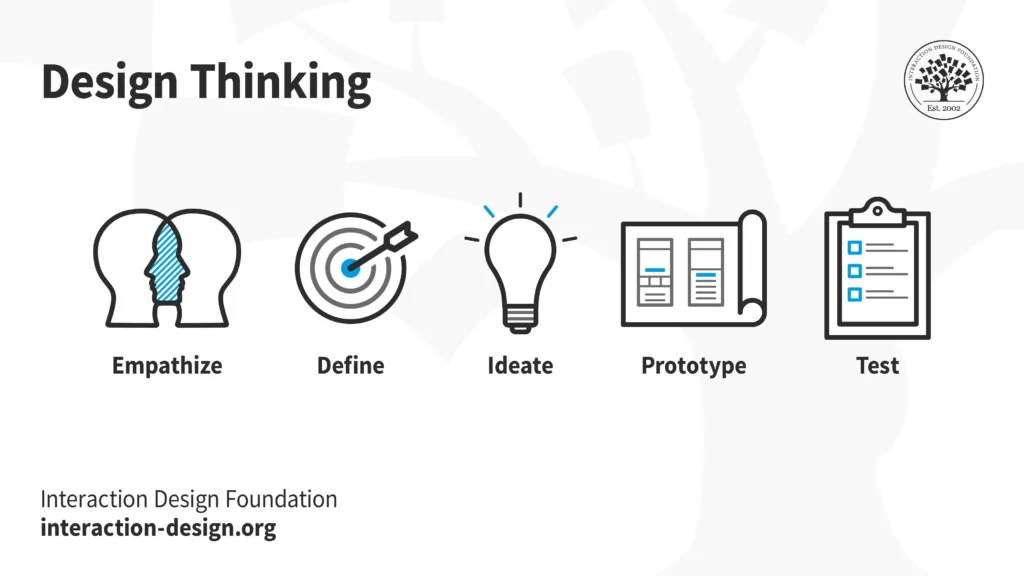As an entrepreneur, I’ve spent countless hours immersing myself in the world of innovation methodologies and design thinking. These powerful tools have been instrumental in shaping my business endeavors, helping me overcome challenges, and nurturing my creative spirit. But recently, I found myself pondering a question that ignited my curiosity: Why do we primarily reserve these strategic and creative approaches for our businesses, and not for the most important project of all — ourselves? Is Design Thinking a potential path to becoming the best version of yourself? I think, yes, but read on and explore yourself.
What we’ll discuss:
- Becoming the best version of yourself
- What is design thinking?
- How can we use design thinking for personal development?
- The five stages of design thinking for personal development
- Conclusion: Design thinking in life?
Becoming the best version of yourself
In life, we all aspire to reach higher ground, to become the best version of ourselves. Whether it’s aiming for a fulfilling career, a harmonious relationship, or simply nurturing greater self-confidence, our journey is a perpetual quest for personal growth. Yet, it’s a path riddled with obstacles and uncertainties, and the joy of the process can often seem elusive. To be your best self means to be true to your values and beliefs. You need to be following your own sense of happiness, meaning, and purpose. However, many people have not reached that alignment in their jobs, careers, or relationships yet. So, how can we achieve this? Design thinking used for personal development might hold the answer.
What is design thinking?
First, let’s clarify what Design thinking is. Design thinking is a creative problem-solving approach used by businesses and organizations that puts people at the heart of the innovation process. It’s a method for tackling complex challenges by emphasizing empathy, collaboration, and iterative thinking. Design thinking encourages a deep understanding of user needs and challenges, followed by the generation of a wide range of possible solutions. Through prototyping and testing, it refines these ideas into practical and user-centric solutions. In essence, design thinking is a dynamic and adaptable framework that empowers individuals and teams to tackle problems with a human-centered focus, fostering innovation and delivering solutions that genuinely resonate with the end-users.
How can we use design thinking for personal development?
Over the past years, I asked myself: Why not apply the same principles of innovation, design thinking, and problem-solving that have proven so effective in business to our personal lives? Why not embark on a journey that couples a strategic, creative approach with personal development? After all, personal growth, like innovation, isn’t a linear path. It’s marked by twists, turns, and moments of feeling stuck or unsure of how to progress.
Personal growth, like innovation, isn’t a linear path.
So, how could we go about it? Following a design thinking process, we’d have to go through 5 stages.
The five stages of design thinking for personal development
I suggest adapting the five stages of design thinking (see image) for a personal development process.

- Empathize: Gain clarity on where we are in life, what challenges we face, and what our needs are.
- Define: Set clear goals and a vision for where you want to go in life.
- Ideate: Get creative and wild about the opportunities ahead of you.
- Prototype: Craft innovative solutions to quickly test those opportunities.
- Test: Analyze your prototypes and reflect on how they fulfill your needs.
Also, don’t forget that this is an iterative process. At any point, you might have to go back to a previous stage, adjust your findings, and review your strategy.
Conclusion: Design thinking in life?
So, is design thinking a potential path to becoming the best version of yourself? I strongly believe so. In the quest to become the best version of ourselves, we often overlook the potential of innovative problem-solving techniques that have revolutionized the business world. However, as an entrepreneur and a seeker of personal growth, I firmly believe that design thinking can indeed be a potential path to self-improvement. By applying the principles of empathy and iterative thinking to our personal development, we can gain clarity about our challenges, set meaningful goals, explore creative solutions, and continually refine our path. Just like innovation, personal growth isn’t a linear journey but a dynamic, iterative process. So, why not harness the power of design thinking to guide us on this remarkable voyage toward becoming the best version of ourselves? Embrace it, adapt it, and allow it to lead you towards a more fulfilling and purpose-driven life. Design thinking is not just for businesses; it’s a blueprint for a better you. If you want to explore this blueprint together, have a look at my life innovation coaching which is based on the ideas I discussed in this blog. Or build your own toolkit with weekly insights from this blog (subscribe below).